Sure, you put ten standardization pilots in a room to specify cockpit callouts, you will come up with eleven ways to do that. But you need them. I use to call this the "ritualization of standardization." If you make a ritual of the way you make these calls, you get used to them and they get easier. If, one day, the callout is missing, your internal alarm should be raised. Here is the way we've attacked it . . .
— James Albright

Updated:
2014-02-29
callouts are generally made by the PM but are sometimes required of the PF or the first pilot to become aware of a requirement. Whenever a callout is missed, the other pilot can make the callout or query the responsible pilot with the question, “callout?” Pilots need not make individual callouts which are made by an automated system, such as EGPWS, which makes the specific callout. callouts are summarized below.
1 — Taking the runway prior to take off
5 — Enhanced Flight Visual System (EFVS) approach

1
Taking the runway prior to take off
When taxiing onto the runway, the PF will:
- Note the ATC clearance, e.g., "I heard two nine"
- Note the runway number on the pavement, e.g., "I see two nine"
- And once lined up, note the aircraft heading agrees, e.g., "I see heading two ninety"
Why do we do this? See the case of Comair Flight 5191.
2
Takeoff
During the takeoff roll pilots will make standard calls in accordance with the AFM or AOM. In the case of the G450:
- 60 kts (PM): “Power set, Elevator Free”
- Maximum low‐speed abort speed (PM): “____ knots”
- V1 speed (PM): “V1”
- Rotation speed (PM): “Rotate”
- Positive rate of climb (PM): “Positive Rate” ...(PF): “Gear Up”
3
Climbing/descending
When 1,000 feet below/above an assigned altitude, the PF calls the altitude passing and the target altitude. The PM acknowledges the call by repeating the callout. These callouts will be made using the “passing___, climbing/descending___” format, so as to avoid any possible confusion between the words often used in altitude reports “to” and “for.” Radio check‐ins with ATC should be made using the same “passing___, climbing/descending____” format.
Why? See the case of Flying Tiger Line 66 and more techniques at Clearance Readback.
4
Instrument approach
You should have standard callouts for instrument approaches that all crewmembers expect and will note when missing. The following are our calls. (Once the runway is in sight by both pilots, only the “stable” call is required.)
- Course movement (PM or PF): “Localizer/Course alive”
- Glide slope movement (PM or PF): “Glide slope alive:
- 1,000 feet above minimums (PM): “1,000 above, stable” (if stable) or "1,000 above, unstable, go around" (if unstable)
- 100 feet above minimums (PM): “100 above MDA” or “100 above DA”
- At DA (PM): “Minimums,” (PF) “Landing” or “Missed Approach”
- Reaching MDA (PM): “MDA ____feet”
- Leaving MDA (PF): “Departing MDA, landing”
- Sighting Lights (PM): e.g., “Lights 1 o’clock” ... (PF): “Continuing”
- No runway at DA or MAP (PM): “No contact, missed approach”...(PF): “Missed Approach”
There are more than a few examples of where standardized callouts on approach would have save the day, but pay particular note to GIII N85VT at Houston. They flew a perfectly good airplane into the ground with the wrong ILS frequency tuned. A proper approach briefing followed by a check for glide slope movement would have prevented this mishap.
5
Enhanced Flight Visual System (EFVS) approach
EFVS callouts will be in accordance with AFM/AOM procedures. As a minimum, the following callouts will be made in addition to non‐EFVS instrument approach callouts:
- With EVFS visual cues (PF): "EVFS lights"
- With actual visual cues (PM): "Lights"
- With actual visual cues (PF): "Landing"
- No later than 100 feet HAT (PF): "Landing" or "Going Around"
6
Visual or circling approach
During a visual approach or circling approach, the PM calls “500 feet, stable” when 500 feet above the runway and the PF calls “Landing.” If the approach is not stable at that point, the PM calls "500 feet, unstable, go around."
7
Stabilized approach
You should have specific stabilized approach criteria and procedures. Here are ours:
We back up every straight-in visual with some kind of guidance, either an instrument approach of an FMS extended LNAV/VNAV centerline. All of these require the approach be stabilized no later than 1,000' above minimums. For any circling or non-straight-in visual approach, we use 500' above the runway. More about this: Stabilized Approach.
We pilots have a "continuation bias" which, despite everything we say, leads us to the "go mode" despite warning sides we should be in "go around mode." While these mishaps have other factors, firmly adhering to stabilized approach criteria would have given each crew a second chance:
